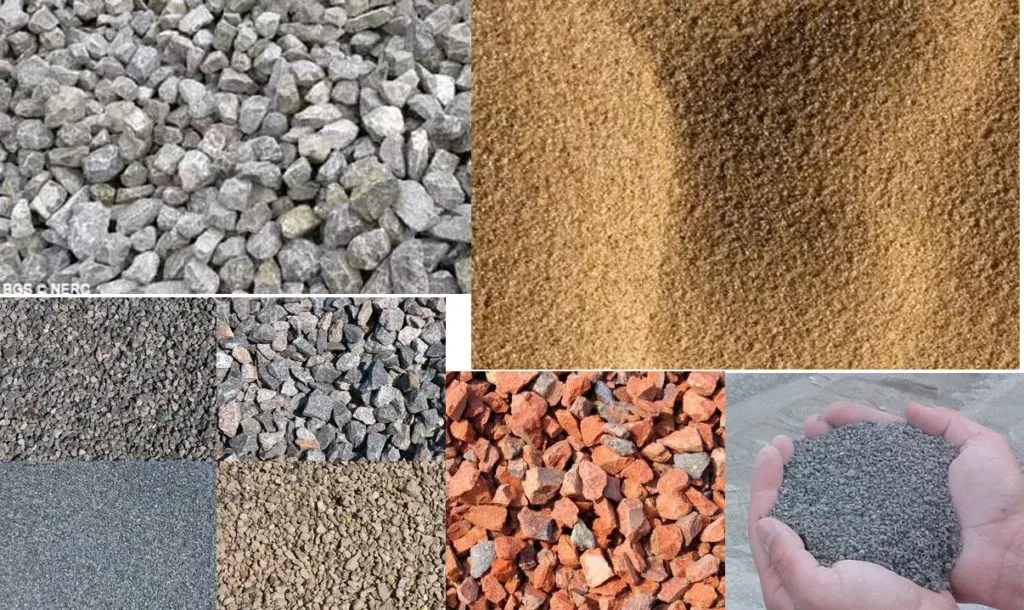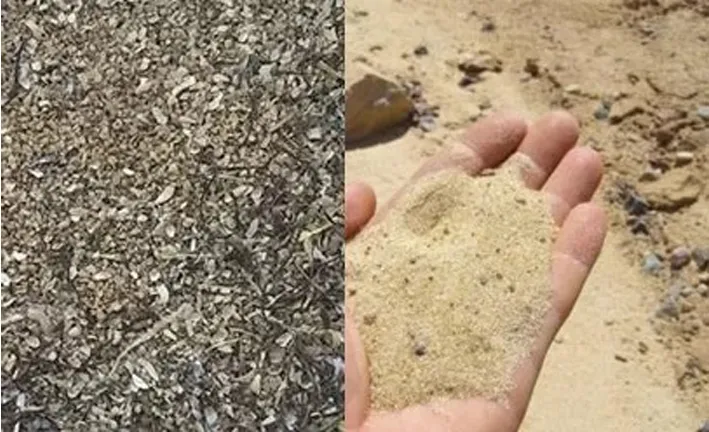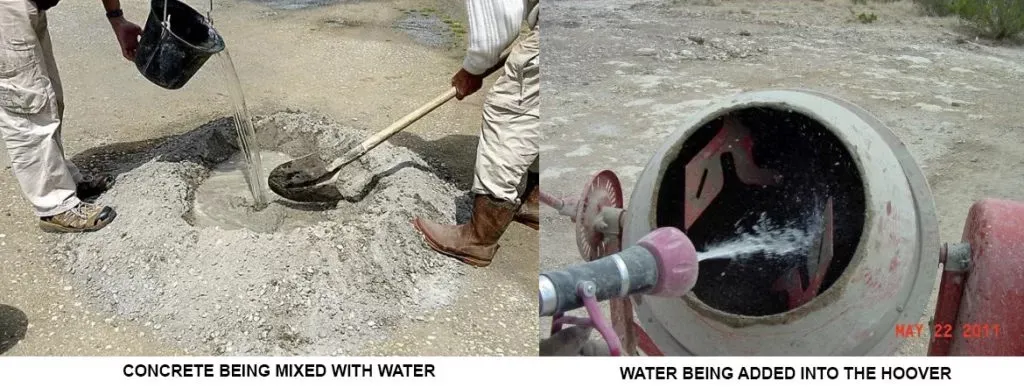If you want to know about the introduction of pile foundation or types of concrete and its uses or concrete mix design, please click the link.
1) Concrete – Introduction
Concrete ( meaning – condensed / compacted) – Composite construction material

- The water reacts with the cement, which bonds the other components together eventually creating a stone-like material , this is called HYDRATION .
- Concrete has many applications and is used to make pavements , pipe , structures foundations, roads, bridges /overpasses , walls and footings for gates etc.
2) Composition of concrete
i) Cement
Cement is the primary binding agent in concrete, which, when mixed with water, forms a paste that coats and binds the aggregates together. Different types of cement can be used depending on the specific requirements of the concrete.

- CEMENT , also called Matrix is the binding material used in concrete. Mostly ordinary Portland Cement or Lime Cement is used.
- Cement is a binder, a substance that sets and hardens independently, and can bind other materials together.
- It should always be measured by weight and not by volume.
- Cement is supplied in bags, each bag of cement weighing 50kg and the volume of cement in one bag is 0.0347 cum (35 liters).
ii) Aggregates
Aggregates, which make up the majority of the concrete’s volume, can be natural or synthetic materials such as crushed stone, gravel, sand, or recycled materials like crushed concrete.
- AGGREGATES are used as filler with binding material, derived from rocks. They form the body of the concrete and reduce shrinkage.

- Most of aggregates are naturally occurring aggregates such as crushed rock, gravel and stone and Artificial or processed aggregates may be broken bricks, slag.
- Depending upon the size the aggregates are classified as : a. Fine aggregates, b. Course aggregates
- Aggregates account for 60 – 70% of the total volume of concrete.
Fine aggregates

- Aggregate size less than 4.75
- Generally consists of natural sand or crushed stones with most particles passing through sieve.
Course aggregates

- Aggregate size more than 4.75
- Generally consists of gravels and crushed stones. The size of aggregates depend upon the nature of work.
iii) Admixtures
- Chemical admixtures are the ingredients in concrete other than Portland cement, water, and aggregate that are added to the mix immediately before or during mixing.
- The use of admixtures offers certain beneficial effects to concrete like improved workability, acceleration or retardation of setting time, reduce water cement ratio, and so on.

There are two basic types of admixtures available: chemical & mineral admixtures.
Mineral admixtures Admixtures like flyash, silicate fume, slag comes in the category of.
Chemical admixtures are added to concrete in very small amounts , broadly categorized as super plasticizers, accelerators, retarders, water reducers etc.
iv) Water
Water is a crucial component in the concrete mix, as it activates the cement and allows the mixture to flow and form a solid structure. The ratio of water to cement is critical, as too much water can weaken the concrete’s strength and durability.

- Water acts as a lubricant for the fine and coarse aggregates and reacts with cement to form the binding paste for the aggregate and the reinforcement. It is normally measured by volumes .
- It is also used for the curing of concrete after it has been cast into the forms.
- Potable water is generally used for mixing and curing of the concrete.
- Less water in cement paste gives a stronger , more durable concrete
- More water will give free flowing concrete with less strength.
4) Water – Cement Ratio
- Water cement ratio is the ratio of the volume of water to volume of cement used in a concrete mix.
- To a great extent Strength and workability of concrete depends on W/C ratio.
- Lower the ratio, the greater is the strength of the mix.
- If water used is less then the strength of concrete get reduced, the resultant concrete will be comparatively dry, difficult to place in position and may pose problems in compaction. Similarly, if the amount of water is more than it would result in the formation of excessive voids, thereby reducing its density, strength and durability.
5) Grades of concrete
- IS 456-2000 has designated the concrete mixes into a number of grades as M10, M15, M20, M25, M30, M35, M40. In this designation the letter M refers to the mix and the number to the specified 28 day cube strength of mix in N/mm sq.
- The mixes of grades M10, M15, M20, M25 correspond approximately to the mix proportions (1:3:6), (1:2:4), (1:1.5:3) & (1:1:2) respectively.
6) Advantages and disadvantages
Concrete can be cast into various shapes and sizes, making it a versatile material for construction. It is commonly used for building foundations, walls, floors, and structures such as bridges and dams.
Concrete can be reinforced with steel bars or mesh to increase its strength and durability, creating reinforced concrete. Additionally, additives such as fly ash, silica fume, and slag can be added to the concrete mix to enhance its properties, such as workability, strength, and durability.
Advantages
- Concrete can handle the compression stresses 10 times more than the tension and the most of loads in our life is compression.
- Concrete is a brittle material which gives the advantage to make a rigid structure.
- Easy to handle over, there are plants that give you ready mix concrete.
- It also gains strength as it ages.
Disadvantages
- Concrete is weak in handling tension.
- Because concrete is a brittle material the strength upon shear (specially at 45 degrees) must be checked.
- Needs another material to reinforce it against excessive shear and tension
Overall, concrete is an essential material in the construction industry due to its strength, durability, versatility, and availability. It is a material that continues to evolve and improve as new technologies and materials become available.